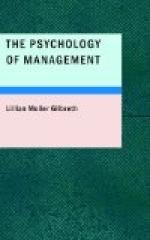SUCH TRAINING PARTIALLY DETERMINES THE QUALITY OF THE WORK.—The importance of sense training can scarcely be overestimated. Through his senses, the worker takes in the directions as to what he is to do, and on the accuracy with which his senses record the impressions made upon them, depends the mental model which he ultimately follows, and the accuracy of his criticism of the resulting physical object of his work. Through the senses, the worker sets his own task, and inspects his work.
SENSE TRAINING INFLUENCES INCREASE OF EFFICIENCY.—With the training of the senses the possibility of increased efficiency increases. As any sense becomes trained, the minimum visable is reduced, and more accurate impressions become possible.[10] They lead to more rapid work, by eliminating time necessary for judgment. The bricklayer develops a fineness of touch that allows him to dispense with sight in some parts of his work.
SELECTIVE POWER OF SENSES DEVELOPED.—James defines the sense organs as “organs of selection."[11] Scientific Management so trains them that they can select what is of most value to the worker.
METHODS OF SENSE TRAINING UNDER SCIENTIFIC MANAGEMENT.—The senses are trained under Scientific Management by means of the various sources of teaching. The instruction card, with its detailed descriptions of operations, and its accompanying illustrations, not only tends to increase powers of visualization, but also, by the close observation it demands, it reduces the minimum visible. The “visible instruction card,” or working model, is an example of supplementing weak power of visualization. The most available simple, inexpensive and easily handled device to assist visualizing is the stereo or three-dimension photograph, which not only serves its purpose at the time of its use, but trains the eye to see the third dimension always.
Much training is given to the eye in Scientific Management by the constant insistence on inspection. This inspection is not confined to the inspector, but is the constant practice of worker and foremen, in order that work may be of such a quality as will merit a bonus.
SENSES THAT ARE MOST UTILIZED BEST TRAINED.—The relative training given to the various senses depends on the nature of the work. When the ear is the tester of efficiency, as it often is with an engineer watching machinery in action, emphasis is laid on training the hearing. In work where touch is important, emphasis is on such training as will develop that sense.[12]
VARIATIONS IN SENSE POWER SHOULD BE UTILIZED.—Investigations are constantly going to prove that each sense has a predominance at a different time in the age of the child or man. Dottoressa Montessori’s experience with teaching very young children by touch shows that that sense is able to discriminate to an extraordinary extent for the first six years of life.[13]
So, also, acute keenness of any sense, by reason of age or experience should be conserved.[14] Such acuteness is often the result of some need, and, unless consciously preserved, will vanish with the need.




